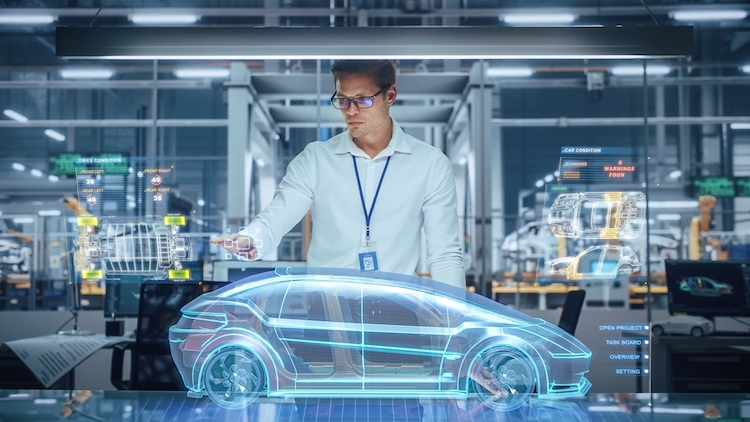AI in CAD/CAM: what it means for manufacturing
Since the 1960s, when General Electric became one of the first big corporations to offshore its production to countries where it would cost less to carry out, we’ve been living in a global manufacturing system.
But today, that system is under more strain than at any time over the last 50 years. Global supply chains are breaking down – pressured by factors like Covid, the Ukraine crisis, and shortages of raw materials and energy.
Labor is also a huge factor. With domestic manufacturing in developed countries like the UK in decline because of global competition, young workers have become less likely to seek a career in the sector – resulting in an ongoing skills gap, which has become a full-blown crisis.
Global demand for manufactured goods is set to rise – but as things stand, the sector isn’t able to meet it. The potential result: a multi-billion-dollar output gap that stymies global economic development and growth.
So – what’s the solution?

Technology to the rescue
For answers, policymakers will naturally look at the big picture: protection measures like trade barriers, tax incentives and talent development schemes.
However, these cure the symptoms of the disease, not the cause. Instead, we need to use technology to enable manufacturing to be faster and more efficient so it can be part of the solution, not the problem.
By using new solutions, we can bring down production costs and improve efficiency, enabling domestic companies to compete. For example, manufacturers globally are now starting to use AI to accelerate CAD CAM programming, enabling them to precision machine components far more efficiently than ever before, without scaling headcounts.
Precision machining is the mechanism for creating the metal components the world needs to function. But a CNC machine, where those parts are made, isn’t easy to use, even for a skilled machinist: a simple component can be made in billions of possible ways, and if the machine is programmed non-optimally then the manufacturer wastes time and materials.
AI changes all that. By using algorithms to eliminate inefficiencies and work out the most efficient solutions, you can accelerate machining with AI, saving manufacturers hundreds of production hours a year in programming and estimating time.
Companies using this software are already reaping the rewards:
- Experts spend less time on time-consuming programming, and invest their time and knowledge in more complex tasks
- Junior programmers are more productive more quickly, and can machine more difficult components
- By reducing their reliance on manual machine programming, factories can manufacture more parts, faster and with less waste
- More money, fewer problems
So, that’s the benefit per factory, or per manufacturer. But what happens if this technology is adopted on a macro level?
If you can make not just one factory more economic, but many factories, then suddenly a lot more options become available:
- We can level the global playing field, as factories in developed nations are again able to compete against their counterparts elsewhere – whether through pricing, efficiency gains, or flexibility
- Stronger domestic sectors mean shorter supply chains, reducing the geopolitical threat from disruptive global crises
- That creates less environmental impact – fewer cargoes going back and forth between East and West
- We can narrow the manufacturing talent gap, meaning we help manufacturers meet rising demand with their existing and future workforces, not least through helping them employ younger talent
- We can even, potentially, encourage the development of a precision manufacturing industry in countries that have no existing base today, fostering global economic growth
Add all those factors together, and you have a situation where domestic manufacturing sectors are attractive places to work, fueled by cutting-edge technology and set up to compete for the future – instead of dwindling assets competing forlornly against cost-cutting adversaries in a race to the bottom.
What does that look like in practice? Well, maybe it’s the difference between old Detroit – a collapsed ‘donut’ city that’s empty in the middle, as its manufacturing core has been hollowed out as the US automotive industry falters – and a new, dynamic Detroit, where new manufacturers, supported by cutting-edge technology, are able to fill the gap, creating prosperous shops and skilled jobs that support the local ecosystem and reinvent a city.
Now, we’re not yet living in a world where AI completely changes how the world makes everything – this technology is in a relatively early stage, despite the efforts of companies like ours! But manufacturers are already rethinking their global strategies to embrace AI, and solutions like these will play a substantial part in creating the green shoots of recovery that our sector requires to survive.
By Theo Saville
Theo Saville is the co-founder and CEO of CloudNC. CloudNC’s mission is to enable single-click manufacturing. Today, it is reinventing precision machining. Manufacturers using its CAM Assist solution, which accelerates CNC CAM programming by applying AI, each save hundreds of production hours every year. It is available today at https://www.cloudnc.com.
